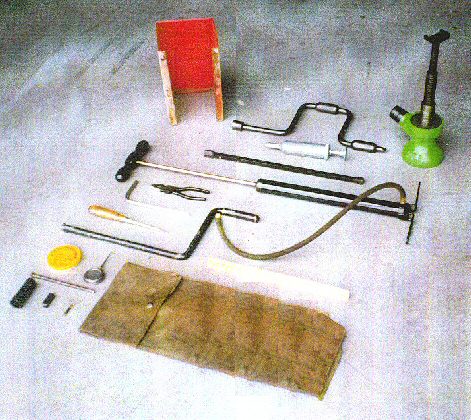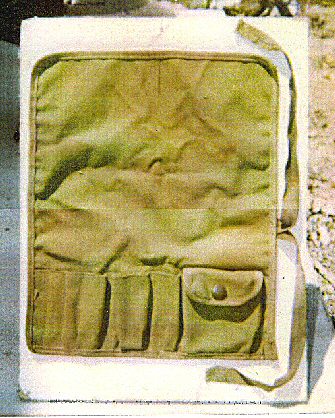site map
Jowett Jupiter Specifications, Performance and Statistics
Jowett Jupiter first appeared in the London Motor Show, October, 1949 as a rolling chassis, having been
designed in four months by the famous (of Auto Union pre-war, and Cisitalia immediately
postwar) Austrian engineer Dr Robert Eberan-Eberhorst.
The tubular chassis was made from a relatively light-weight but equally-strong steel, high
in chromium and molybdenum; it had been developed for fighter aeroplanes like the Spitfire. Nice for us is that it does not
rust!. Bodywork was designed (also,
astonishingly in view of its complexity and beauty, also in four
months) in-house by
Jowett's body stylist Reg Korner, made form aluminium alloy. The first two
complete Jupiters were on the road by March 1950. The
third Jupiter raced at Le Mans in June 1950 and won its class.
Initially it was named the Javelin-Jupiter but after a while it was re-named the Jowett Jupiter.
First
production batch of Jupiters (five) were completed at the Works
September to December 1950. One was shipped to the French agent, the
other four were road-test, demonstrator and show cars.
The very
last Jupiter left the Jowett factory in November 1954. The Jowett
factory built 827 standard-bodied Jupiters during those years, of which
733 were the Mk1 and 94 were the Mk1a.
But also a further 74 Jupiters went out as fully equipped rolling chassis
normally to coachbuolder to build special bodies on them, however
three of these rolling chassis later received standard bodywork making
830 the total number of standard Jupiters that once existed. It has
been established that 64 of the rolling chassis are known to have
received coachbuilt bodies, the fate is unknown of the others.
See below for the
Jupiter's standard tool list and images showing what some of the items look like. Also below, a cmparison of how the Mk1a differed from the Mk1.
Engine.
The Jowett Jupiter engine is a good example
of British engineering eccentricity. It was designed by Gerry Palmer
(he also designed the Jowett Javelin, and later the MG Magnette,
Wolseley 4/44 and variants)
This engine was his first and last engine design, initially for the
Jowett Javelin. It is a horizontally opposed four cylinder unit
(Flat-Four) of bore
72.5mm x stroke 90mm swept volume 1486cc. (90.6cu-in). Compression
ration 7.6:1 or 8:1
dependent upon destination country's petrol. the version for the
Jupiter was developed to produce some more power than that needed for
the Javelin.
The
Javelin version of te enginme developed 52.5 BHP wheras the Jupiter
version - same swept volume (1486cc) but higher compression and different carburettors, developed 62.5 BHP with even more
deveoped for the Mans Jupiters
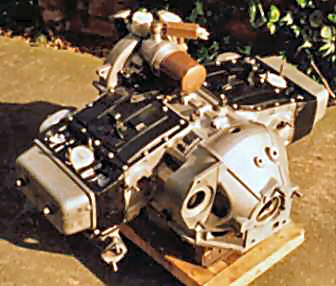 |
Left: rear view of a Jowett Jupiter engine but without the
two carburettors. At the top is the housing of the updated (throwaway) oil filter. Below one of the heads
the left side exhaust manifold can be seen. The clutch housing is detachable; gearbox and
starter motor attach to the clutch housing. Beneath the black cover-plates on the top of
the engine the pushrods can be accessed. Aluminium covers (extreme right and left) hide
the rocker gear. The whole engine is sealed and runs under a slight vacuum -
positive crankcase ventilation - universal today but a novelty when the engine was
designed in 1946. |
| Right: view of the engine installed in a
Jupiter. The water pump pulley can be seen at the top, with oil filler pipe and dipstick
below. One of the carburettors and the Lucas distributor can be made out on the left, as
can the aluminium water transfer pipe which connects the head coolant to the crankcase
front water channel - the water then flows round the front timing cover to the water pump
at the top. The strange white object top left is part of the Jupiter bodywork, since the
whole of the bonnet is hinged up for the photograph. Red stripe is wing piping |
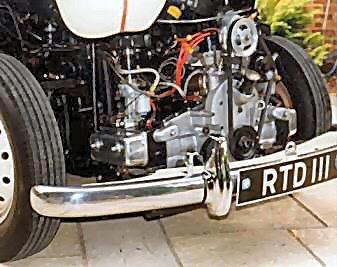 |
Overhead valves are operated by rather long pushrods from a central camshaft mounted
directly in the crankcase above the crank. Camshaft end-float adjuster can be made out in
the above engine-installed photograph, just below the filler pipe.
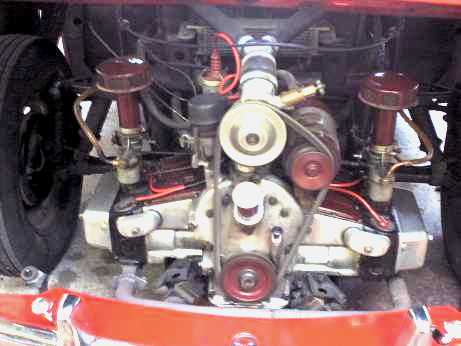 |
Another view of an engine installed in a Jupiter.
This is in the last Jupiter built, the Mk1a owned by Pat Lockyer. He
rebuilt the engine himself after welding up a crack in the aluminium crankcase that was letting water
into the sump.
As with everything Pat Lockyer did, this engine runs silently, superbly, and
the car travels swiftly. |
For the standard engine, maximum power occurs at 4,500rpm (Standard
Jupiter Mk1, Mk1a) and 5100rpm (Jupiter type R4 which had a
slightly raised 8.5:1
compression ratio). Crank is 3-bearing hardened type. The crankcase
block is of aluminium alloy split into two halves vertically down
the centre-line so that the main bearing housings (and the camshaft
bearing housings) are
half in one side, half in the other, with some big big
bolts clamping both halves of the crakcase together.
The cylinder heads are cast iron - fortunately for us 70 or more years on as this makes them
relatively easy to repair and convert to lead-free petrol. Oil filter housing is a separate
casting bolted to top of engine block via an obtuse-angled vee - always a conversation
piece as it is such fun to keep oil tight. The water pump is perched above the engine as a
separate unit that also carries the fan spindle, thus the water pump has to suck hot water
from the engine, or more correctly, cylinder heads. Since the pump is joined to the top of the
engine via a small piece of hose, and since the pump is triangulated to the dynamo and
engine for fan-belt tensioning, you have to ensure that the pump does not get too close to
the distributor. Radiator is mounted above and behind the engine in a compact but unusual
layout.
Nevertheless the Jupiter's power of over 60 genuine BHP was quite good for the
period from only 1486cc. Good enough for 10 major victories in three in-era seasons.
Transmission
Compact transmission (gearbox), as designed
for the Javelin, is a separate unit from the clutch housing. It
offers 4 forward ratios
(synchromesh on 2nd, 3rd and top) plus reverse. Gear lever is
steering-column-mounted. the gearbox ewas initally made by an outside
contractor, meadows, but later Jupiters had Jowett-built interiors.
Steering
Steering is by a solidly mounted rack-and-pinion unit, rare for it's time. As a result
the steering is light and positive.
Brakes
Apart from the very early Mk1 Jupiters, the Girling brakes are all-round hydraulic with
twin leading shoes at the front. Very early Jupiters were hydraulic leading/trailing at
the front, mechanical rear, which meant that should the hydraulics fail you still had some
braking! Brake shoe area is very adequate except for fast mountain descents with heavy braking, when fade can
be experienced.
Suspension
Front suspension is independent, unequal length wishbones, with torsion rod
springs and telescopic shock absorbers.
Rear suspension (Mk1, Mk1a) is live axle, well-located by Panhard Rod (so - no axle
tramp!), with transverse torsion rod springs and telescopic shock absorbers.
Jupiter R4 is the same
except semi-elliptical leaf springs instead of torsion rods.
Interior and hood (ragtop)
The single bench seat accommodates two, but can accomodate three. It is upholstered
in leather (colour either a mid-tan or Bordeaux) while the rest of the interior is covered in a
matching ambla (rexine). Winding windows are provided. The hood folds out of sight behind the seat,
and can be raised rapidly in the event of a sudden downpour. Hoods are either beige (all
body colours except white) or black (white bodies only). White cars had Bordeaux interiors only.
Red cars had mid-tan interiors only. Other body colours could have either of these two interior colours.
Production Totals
It is confirmed that 897 cars
(all bodies) were built on the Eberhorst Jupiter frame. But another
five MAY have been built, making the maximum possible the total of 902
cars on the Eberhorst Jupiter frame. A good few had coachbuilt bodies,
as during 1950-1951 production of standard Jupiters was slow.
Also for 1952-1954 the Monte Carlo Rally no longer allowed open cars,
but for those years it did allow coachbuilders saloon-bodied cars on the chassis of
standard open cars, so some FHC Jupiters were built with the Monte Carlo Rally in mind.
The three Jupiters type R1 were on
the Eberhorst-designed chassis-frame but the Jupiter type R4 was not on
the Eberhorst-designed chassis-frame.
It is known that 829
standard-bodied Jupiters once existed, of which a good 50% still exist
in some form. many well-restored and running.
| |
Mk1 |
Mk1a |
R1 |
R4 |
| Right Hand drive |
498 |
57 |
3 |
3 |
| Left hand Drive |
233 |
37 |
0 |
0 |
| Special bodied Jupiters |
at least 64 |
1? |
|
|
These diagrams are of the Jupiter Mk1a version,
taken from a 1953 AUTOCAR magazine.
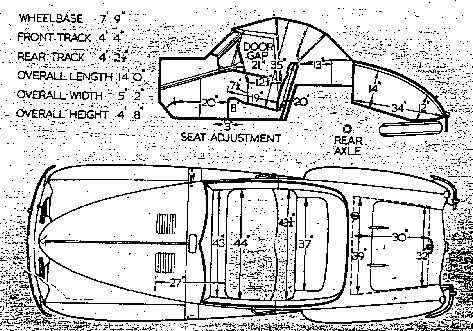
The dimensions in the above diagrams are in inches, with the seat in its central
position. Jupiter Mk1 boot locker is 25 inches x 10 inches x 31 inches
The main differences between the Mk1 and the Mk1 are:
Boot: Mk1 - internally accessible by tilting the seat back. Mk1a - externally
accessible, slightly greater capacity.
Spare wheel storage - For the Mk1 is reached through a special small door at the rear, but in
the Mk1a you have to unload the boot as it is under the boot floor..
Tankage: Mk1 - 11 Imperial gallons, Mk1a - 8 Imperial gallons.
Hood (soft top): Mk1a hood was raked further back than that of the Mk1.
Instrument Panel:
Mk1 - walnut veneer panel with recessed instruments in direct view of
the driver. Mk1a - metal panel painted body colour with chrome bezel
instruments placed
central to the car's axis. This panelwork made it much easier for RHD
and LHD Jupiters - just swap the rev counter and the speedometer - so
photo below
Leg room: Mk1 - Plenty OK for a six-footer. Mk1a - slightly less.
In sum, the Jupiter Mka has the externally accessible larger boot, and is even rarer
than the Mk1 and of
course had all the latest mechanical updates. The Jupiter Mk1 has a nicer instrument panel,
instruments, and instrument layout, and greater legroom and tankage - and is still pretty rare!
Statistics
| |
Mk1 |
Mk1 |
R4 |
R4 |
| Length |
168in |
427cm |
159in |
404cm |
| Kerb weight |
1895lb |
860kg |
1658lb |
711kg |
| Height |
56in |
142cm |
54in |
137cm |
| Width |
62in |
157cm |
62.5in |
159cm |
| Wheelbase |
93in |
236cm |
84in |
213cm |
| Track Front x rear |
52 x 50.5 |
132 x 128 |
52 x 49 |
132 x 124 |
| Power |
62.5bhp |
46.6kw |
64bhp |
47.7kw |
| Performance |
|
|
|
|
| 0 to 60mph |
14.2sec |
|
|
|
| standing quarter-mile |
21.0sec |
|
|
|
| max speed |
88mph |
142km/hr |
100mph |
161km/hr |
| Fuel consumption |
30mpg |
9.4l/100km |
|
|
The Jupiter R4 was speed-tested at MIRA (Motor Industry Research Association) test ground at
Nuneaton. It just exceeded 100mph with overdrive top engaged and the hood removed. It was
the cheapest 100mph car at the 1953 London Motor Show.
Here is the
list of tools, issued by Jowett Cars Ltd with every new Jupiter - this
actual list went out with Jupiter E1 SA 563R on 23 January 1952
Starting handle
Spare wheel,
tyre pump with connection, tyre valve key, wheel brace, jack, tommy bar
Grease gun, oil
can, axle drain plug key, sump drain plug key
Cylinder head
spanner. open-ended spanners - sizes quoted in inches:- 3/16 x 1/4", 5/15" 3/8", 7/16" x 1/2", box
spanner 5/16" x 3/8", spark plug spanner
Screwdriver,
pliers, ignition screwdriver, tube for brake bleeder valve, budget lock key
Tool roll
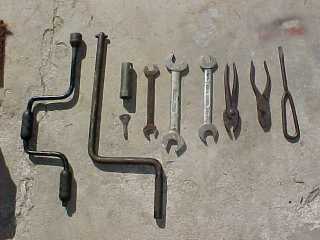 |
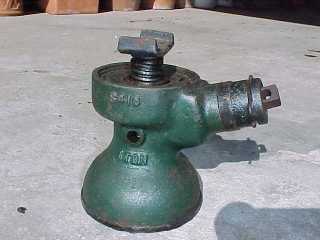 |
| Some of the Jupiter's tools - these are to the
correct pattern |
Close-up of the correct Jack supplied with the
Jupiter |
Here is a rear view of the Mk1a showing opening boot and symmetrical metal
instrument panel
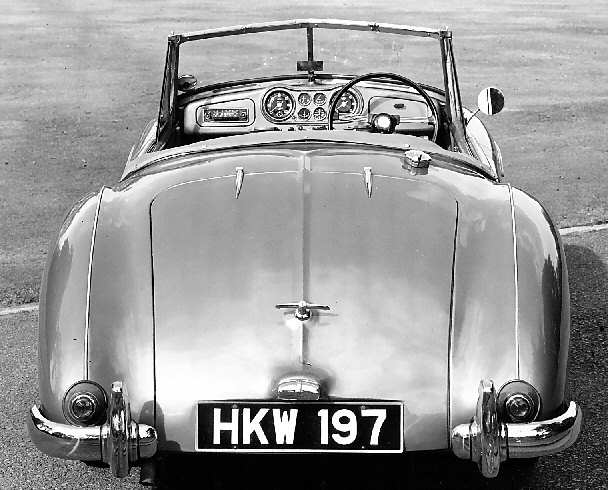
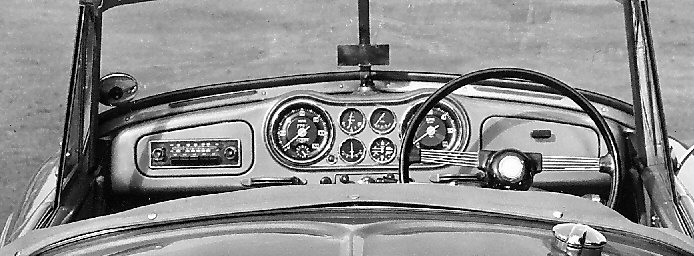
The radio was an optional extra of course - a radio could be fitted to the Mk1 as well as the Mk1a
||Jupiter (cars!) photos||Buy the
Jupiter
Book||Buy Crowood's Javelin/Jupiter
Book||
||Magazine
Page||Magazine page start to 2003||Magazine page 2003 to 2005||Magazine page 2005 to 2008||Main
Index
Page||Famous
Jupiter Owners||
||Book
List||Competition
History||Production
History||Jowett
Genealogy||The Farina
Jupiters||
|A handbuilt car||Jowett
Clubs||Le Mans Jupitour 2000||Blois
Jupitour 2003||Jupitour
2006||Jupitour
2007||
||Quirky
Jupiter photos||A
Jupiter travels to Hyeres||




